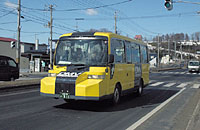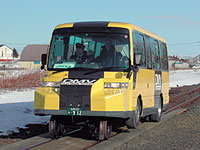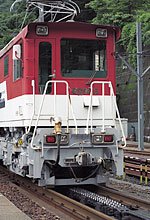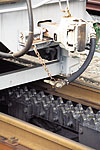Special Feature![]() Travel Japan by Train
Travel Japan by Train
Is that a bus or a train? The DMV
The Dual Mode Vehicle, or DMV, looks like a bus. Except that it runs on both ordinary roads and railway track. On the road it drives like a bus. But once it positions itself over the track, iron wheels are lowered from the front and back and the front tires are raised above the rails. The rear tires remain in contact with the track, and they move the vehicle once more, driven by the diesel engine.
The DMV was conceived abroad some time ago but never used as a working vehicle until 2004, when JR Hokkaido developed a system that converts quickly from rail to road and back again. Trial passenger operations began in April 2007 with three return runs per day on track skirting the Okhotsk seacoast in Hokkaido. The “bus-train” travels about 11 km on track and 25 km on road (travel time: about 1 hour, 10 minutes). The vehicle’s configuration is based on a small bus design. It holds 12 seated passengers. JR Hokkaido hopes to introduce a DMV that has two cars coupled together, with space for passengers to stand when all seats are occupied. The company wants to use it not only for tourism but for ordinary transit as well.
Switchback train zigzags up steep slopes
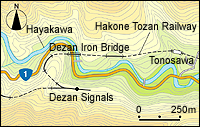
Trains zig and zag their way through switchbacks to climb or descend at particularly steep places. The map shows part of the track of the Hakone Tozan Railway.
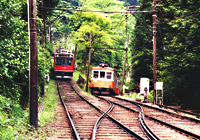
The Hakone Tozan Railway was constructed in steep terrain to take passengers into the highlands. There are switchbacks in three separate locations along the 15-km track.
Iron wheels on rails work well because of the frictional force that prevents the wheels from slipping. But if the incline were steeper than a certain amount the wheels would slip, and the train could not stop when going downhill, either. So railroads try to follow gentle slopes. In steep mountainous terrain, a switchback may be used. The train climbs to a certain point, then switches to another track that zigzags back and keeps climbing. Stopping and starting in this way, the train increases or decreases its altitude little by little.
Switchbacks were once quite common on mountain track in Japan, but advanced tunnel digging technology and stronger train motors have made them rare today. The photo shows a section of switchback track operated by Hakone Tozan Railway. The difference in elevation is 550 meters over 15 km of track, and in some places the gradient is 80 per mill, said to be the limit for ordinary rail transport. (A gradient of 80 per mill works out to a climb of 80 meters over a distance of 1 kilometer.)
The Abt rack and pinion system: Cogs and teeth for steep slopes
A rack rail between the running rails of a mountain railroad makes it possible for trains to go into mountainous areas, and for this reason the system is sometimes compared with switchback track. Cogwheels under the train body mesh with the rack rail, and when they turn they propel the train up or down the track. Rack rail shapes and the number of plates vary, according to the method used. The Abt system was invented by Roman Abt, a Swiss engineer, and uses two or three steel plates with the teeth staggered. In Japan, only one section of track now uses the Abt system, on the Ikawa Line of Oigawa Railway in the southern Japanese Alps of central Shizuoka Prefecture. The Abt track is relatively new—it dates from 1990. It has attracted plenty of attention because its maximum gradient is 90 per mill. ![]()
